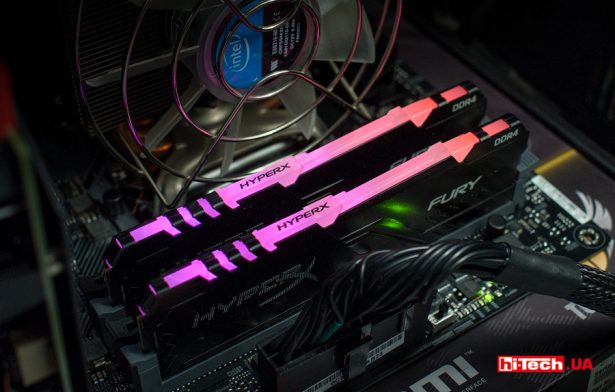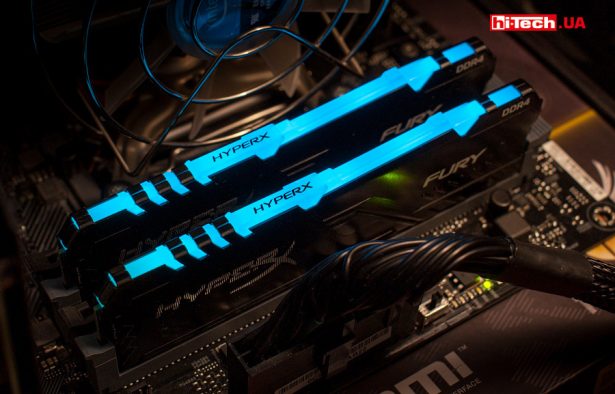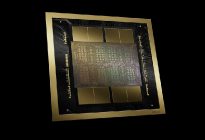Kingston HyperX FURY DDR4 RGB HX432C16FB3AK2/16 RAM review: 3200 MHz frequency and RGB lighting
20.03.20
Modern systems, whether Intel or AMD, are very sensitive to RAM speed.
But as experiments show, high-performance DDR4 modules with frequencies of 3800, 4000 MHz, with a significant difference in price, compared to 3000, 3200 MHz, do not provide such a big gain in speed.
Therefore, DDR4 memory options with frequencies around 3200 MHz turn out to be the golden mean if you want to add performance to the system without spending too much money.
Getting to know the memory kit
Relatively recently, last year, Kingston greatly updated the HyperX FURY DDR4 family of RAM.
Let us remind you thatHyperX FURY is a more affordable product compared to HyperX Predator. ![]()
![]() A kind of option for prudent enthusiasts, gamers, for whom not only advanced characteristics, but also price are of considerable importance.
A kind of option for prudent enthusiasts, gamers, for whom not only advanced characteristics, but also price are of considerable importance.
The HyperX FURY DDR4 range includes models with frequencies from 2400 to 3733 MHz with module capacities of 4, 8, 16, 32 GB.
All memory modulesKingston HyperX FURY DDR4 are made in the same style with black radiators.
Options with built-in RGB lighting are also available.
The kit presented in the test is KingstonHyperXFURYDDR4RGB HX432C16FB3AK2/16 –this is memory with a frequency of 3200 MHz, equipped with RGB backlighting and consisting of two modules of 8 GB each.
A similar kit without backlight has the index HX432C16FB3K2/16.




Kingston HyperX FURY DDR4 RGB HX432C16FB3AK2/16 memory is supplied in a blister. ![]() In addition to the modules themselves, the kit includes a branded sticker and a short manual.
In addition to the modules themselves, the kit includes a branded sticker and a short manual.

Compared to their counterparts without backlight, these strips, due to the presence of additional diffusers, turned out to be higher. ![]()
![]() Height dimensions are 41.2 mm versus 34.1 mm for HyperX FURY DDR4 memory without backlight.
Height dimensions are 41.2 mm versus 34.1 mm for HyperX FURY DDR4 memory without backlight.

HyperX FURY DDR4 RGB HX432C16FB3AK2/16 is slightly higher than standard DDR4 modules
In most cases, this does not matter, but if the system uses a large cooler with a “sweeping” radiator, for example Aardwolf Performa 10X, then there may be problems with installing the module in the first (closest to the processor) slot.
Kingston HyperX FURY DDR4 RGB HX432C16FB3AK2/16 comes pre-installed with two XMP profiles: 3000 MHz with timings 15-17-17-36, voltage 1.35 V and 3200 MHz with slightly higher timings 16-18-18-36, voltage 1 .35 V.
RGB backlight
Under the translucent diffuser, which stretches along the entire module, there is a series of RGB LEDs.
To control the Kingston HyperX FURY DDR4 RGB backlight, the proprietary HyperX NGENUITY application is provided.
It is noteworthy that at the time of writing, it was only available as a beta version and was distributed exclusively through the Microsoft Store application market.
A series of different dynamic effects are provided with adjustment of speed, brightness, color selection, etc.
In addition, HyperX FURY DDR4 RGB can be synchronized with other computer components through motherboard lighting systems (ASUS Aura Sync, MSI Mystic Light, Gigabyte RGB Fusion 2.0, etc.).
The lighting looks high quality.
Let us note an interesting detail. Infrared transmitters and receivers are located on both sides of the boards (marked in the photo below). With their help, the lighting and effects of the modules are coordinated with each other for complete synchronous operation.

Connect

Test platform configurations:
Intel platform
- Processor: Intel Core i5-9400F
- Motherboard: ASUS TUF Z390-PRO GAMING
- RAM: 2×8 GB DDR4 (Kingston HyperX FURY DDR4 RGB HX432C16FB3AK2/16)
- Operating system: Windows 10 Pro 64 bit
AMD platform
- Processor: AMD Ryzen 7 2700 (ZEN+ architecture)
- Motherboard: ASUS ROG Strix X470-F Gaming
- RAM: 2×8 GB DDR4 (Kingston HyperX FURY DDR4 RGB HX432C16FB3AK2/16)
- Operating system: Windows 10 Pro 64 bit
When the system is turned on for the first time after installing the modules, the memory starts at a frequency of 2400 MHz with timings of 17-17-17-39 and a voltage of 1.2 V.
By choosing one of the pre-installed XMP profiles, you can run Kingston HyperX FURY DDR4 RGB HX432C16FB3AK2/16 in 3000 MHz mode with timings 15-17-17-36, voltage 1.35 V, or 3200 MHz with slightly higher timings 16-18- 18-36, voltage 1.35 V.
It should be noted here that for the Intel Core i5-9400F processor the native memory frequency is up to 2666 MHz, and for the AMD Ryzen 7 2700 – up to 2933 MHz.
Therefore, in both cases, memory operation at higher frequencies is not guaranteed.
But this is in theory, but in practice, eighth and ninth generation Intel Core processors usually work without problems with much higher RAM frequencies, for example, 4000 MHz or even more (the limiting factor is the capabilities of the DDR4 modules themselves).
With AMD systems the situation is more complicated.
AMD Ryzen processors of the ZEN (Ryzen 1000 series) and ZEN+ (Ryzen 2000 series) architectures are much more “picky” when it comes to RAM. They require more scrupulous attention to timings and other parameters and do not have the same high frequency RAM potential as in the case of Intel.
The situation has improved significantly in the Ryzen 3000 series processors (ZEN 2 architecture), but still, on Intel platforms it is better to reveal the maximum capabilities of RAM.
Be that as it may, both in the case of a platform based on Intel Core i5-9400F, and in the case of a platform based on AMD Ryzen 7 2700, the systems worked stably without any problems with the XMP profile of 3200 MHz with timings of 16-18-18-36 , voltage 1.35 V.
It is curious that the Intel Core i5-9400F system launched with the memory parameter Command Rate 2T, and the system with AMD Ryzen 7 2700 even launched with a lower (this is good) Command Rate 1T.
Experimenting with overclocking
The Thaiphoon Burner app indicates that our Kingston HyperX FURY DDR4 RGB HX432C16FB3AK2/16 modules are based on Hynix DJR (D-die) memory chips.
Memory modules are peer-to-peer (memory chips are located on one side).
This is very interesting, judging by the information from the hardwareluxx.de forum, where statistics are collected on types of chips and names of RAM modules based on them, in many Kingston HyperX FURY DDR4 modules with a frequency of about 3200 MHz, including HyperX FURY DDR4 RGB HX432C16FB3AK2/ 16, Hynix CJR (C-Die) microcircuits are used.
According to rumors, Hynix D-die is a more modern version of Hynix C-die with slightly better parameters.
The presence of Hynix DJR (D-die) chips in our modules, rather than Hynix CJR (C-Die), is probably related to the production date.
We received a “very fresh” memory for testing, released in January 2020.
When experimenting with memory overclocking, it is useful to have temperature sensors on the modules. Unfortunately, there are no such sensors in the HyperX FURY DDR4 RGB HX432C16FB3AK2/16. At least they were not displayed in the latest version of the AIDA64 diagnostic application.
Let’s see how the HyperX FURY DDR4 RGB HX432C16FB3AK2/16 modules performed when overclocked.
During the experiments, we did not set a goal to find any extreme overclocking modes. It was interesting how the memory would behave when using safe voltage levels for the RAM and DRAM controller, and a reasonable balance of frequencies and timings.
To check the stability of operation, we used the memtest application, the built-in memory benchmark in AIDA64, and ran the 3DMark gaming benchmarks.
Overclocking based on Intel Core i5-9400F
Keeping the same timings 16-18-18-36 as for the XMP 3200 mode and reducing the Command Rate to 1T, we were able to run the modules at 3333 MHz at the same voltage of 1.35 V.
Further steps to increase the frequency required increasing the timings and playing with the RAM voltage, as well as the VCCIO and VCCSA voltages.
Intel results:
- 3333 МГц, 16-18-18-36-1T, 1,35 В;
- 3466 МГц, 17-19-19-36-2T, 1,39 В;
- 3600 МГц, 18-20-20-39-2T, 1,42 В;
- 3866 МГц, 19-21-21-42-2T, 1,44 В;
- 4000 МГц, 19-22-22-43-2T, 1,45 В.
They did not experiment further. Surely the memory would have started at a frequency of more than 4000 MHz, but this would have required an even greater increase in timings.
Overclocking based onAMDRyzen 7 2700
We managed to reach the frequency of 3333 MHz using the same timings as for the XMP 3200 mode. To do this, we only had to increase the voltage slightly to 1.37.
Further, with the increase in frequencies, we had to increase the timings
AMD results:
- 3333 МГц, 16-18-18-36-1T, 1,37 В;
- 3466 МГц, 16-19-20-36-1T, 1,375 В;
- 3533 МГц, 16-19-20-36-1T, 1,4 В;
- 3600 МГц, 16-19-20-36-1T, 1,41 В;
- 3733 МГц, 16-21-22-38-1T, 1,43 В.
If we used a ZEN 2 architecture processor (Ryzen 3000 processors), the results would probably be a little better. As for a ZEN+ architecture processor, it turned out quite well.
General observation for both platforms.
An increase in frequency above 3333 MHz is accompanied by a forced increase in timings. Even a significant (within reason) increase in the supply and controller voltages does not allow setting relatively low timings at higher frequencies.
According to subjective sensations, the memory heatsinks heat up moderately, including when the voltage increases to 1.45 V (a fairly high voltage level).
Conclusions
According to the test results, even in the case of computers based on AMD Ryzen processors of the previous generation ZEN+, you don’t have to worry too much that the system will start “in 3200 MHz memory mode.”
There are also certain reserves for overclocking.
The frequency of 3333 MHz is achieved while maintaining the “native” timings. If desired, you can achieve fairly high frequencies, but the timings will then be relatively large.
In general, we would call the overclocking potential average. The Hynix DJR (D-die) chips used here are not the option that enthusiasts and those who like to “squeeze all the juice out of the system” usually chase after.
Kingston HyperX FURY DDR4 RGB HX432C16FB3AK2/16 is perfect for users who are not planning any deep experiments.
Installed and launched the pre-installed XMP profile with a frequency of 3200 MHz and enjoy trouble-free, stable operation of the system.
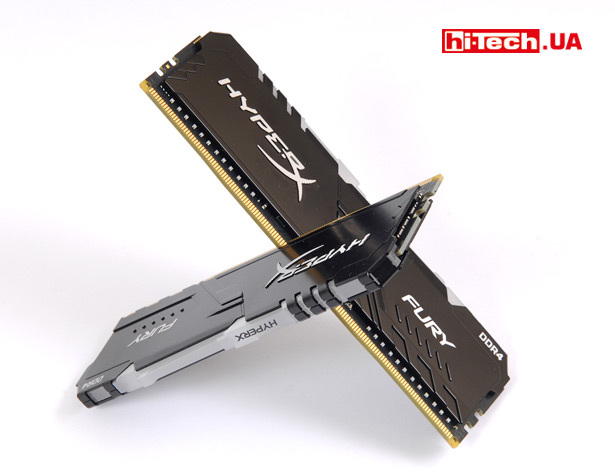
Don’t also forget that by choosing Kingston HyperX FURY DDR4 RGB HX432C16FB3AK2/16, you are getting a device from a renowned brand, backed by a long-term “lifetime” warranty and a very reasonable price, considering the presence of backlighting.
If we compare Kingston HyperX FURY DDR4 RGB HX432C16FB3AK2/16 with the same modules, but without backlight (HX432C16FB3K2/16), then the difference is quite noticeable (about $15).
The lighting itself is very decent and functional, now you can see for yourself what is more important to you…
Characteristics Kingston HyperX FURY DDR4 RGB HX432C16FB3AK2/16 |
|
| Declared frequency: | 3200 MHz |
| XMP1 profile: | 3000 MHz, 15-17-17-36, 1.35 V |
| XMP2 profile: | 3200 MHz, 16-18-18-36, 1.35 V |
| The capacity of one memory stick: | 8 GB |
| Memory modules included: | 2 × 8 GB (16 GB total) |
| Radiators on chips: | yes |
| Memory chips: | Hynix DJR (D-die) |
| Additional features: | controllable RGB backlight |
| Supplier: | Kingston representative office in Ukraine |
| Price: | $107 |
Rating:
+ heatsinks on memory chips
+ peer-to-peer layout
+ adequate cost, considering the presence of RGB backlighting
+ lifetime warranty
+ functional RGB backlight
– in rare cases, the increased height of the modules can lead to difficulties when installing a large processor cooling system
– no built-in temperature sensors
Engineer of the Test Laboratory
вологість:
тиск:
вітер:
Acer Predator X27U monitor review: Achilles?
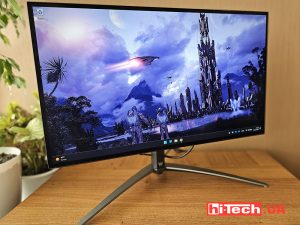
The Acer Predator X27U gaming monitor has the popular 27” diagonal, OLED matrix, 240 Hz refresh rate, interesting design and additional useful features. But is everything about it so perfect?
NVIDIA buy Run:ai for $700 million. It’s Israeli startup develop AI infrastructure optimization
artificial intelligence business NVIDIA serverRun:ai’s Kubernetes-based solution helps enterprises effectively manage computing infrastructure for AI tasks in a cloud-like manner
Blackview BL9000 Pro rugged smartphone equipped with Dimensity 8020, 8800 mAh battery and FLIR thermal imager
Android MediaTek protection smartphone SPONSORED CONTENTThe Blackview BL9000 Pro smartphone is protected according to the MIL-SPEC 810H standard and complies with IP68/IP69K. The battery capacity is 8800 mAh, supports 120 W fast charging




